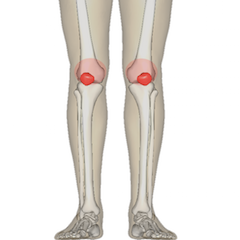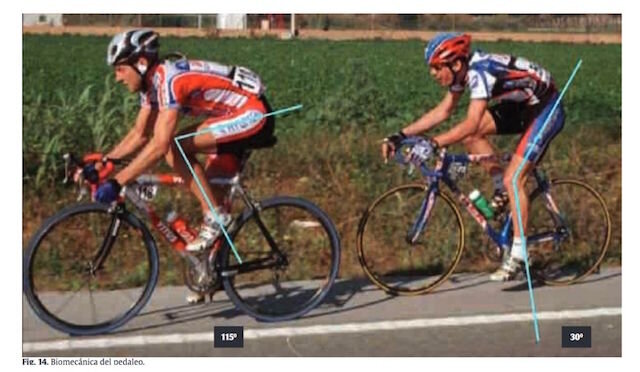Improper saddle height is the leading cause of overuse injuries in cycling and mountain biking. Simply adjusting the seat up or down changes the joint angles and ranges of motion while also altering the amount of force you can apply to the pedals.
Some cyclists ride with a seat too high, however, it’s significantly more common, by about 100 to 1, that cyclists ride with a seat too low. Every cyclist has an optimal saddle height - the height with the most muscle activation while balancing the muscle activity evenly.
Low Saddle Symptoms
There are 4 main sign or symptoms that your bicycle seat is too low:
Your foot is flat on the ground
Knee pops or clicks
Knee pain
Lack of pedal power
Let's analyze each one of these further.
Foot flat on the ground
While this isn’t a symptom, it is the most obvious indicator that your saddle is way too low. If your foot is completely flat or close to it while stopped, your saddle is not millimeters too low, but inches.
Being able to touch the ground without getting out of your saddle is certainly convenient, but this position is horrible for pedal power and even worse for your knees.
READ: “Should My Feet Touch The Ground” - If you would like a more in-depth explanation, I dedicated an entire article to this.
sS = Saddle Setback
CL = Crank Length
Hd = Handlebar Drop
sH = Saddle Height: Measured in millimeters (mm) from the crank axle to the top of the midpoint of the saddle.
knee popping
Image Source: Wikimedia Commons
If your knee(s) is clicking or popping consistently at the top of your pedal stroke, even without pain, then it’s time to stop and reevaluate your seat height.
If the clicking is caused by your kneecap (patella) and femur not moving properly, you are setting yourself up for knee pain and possibly “Biker’s Knee” or Patellofemoral Pain Syndrome.
Riding with the seat too low or mashing on big gears for too long are both causes of knee clicking while bicycling.
READ: “Why Does My Knee Pop When Cycling” - I wrote an entire article about this, so check it out if you would like more info.
Pain in The front of your knee
A low saddle causes excessive knee flexion and commonly results in patellar tendinitis. This is characterized by pain in the front of the knee and is caused by the high compressive forces on the kneecap and tendons as you pedal.
Pain in the front of your knee (around the kneecap).
You might hear a clicking or popping noise(s) before you experience knee pain, and those clicking/popping sounds are your body’s way of alerting you that something needs to change.
*NOTE ABOUT THE PICTURE: Even though the lady in the above picture is riding with her seat way too low, just casually cruising around the neighborhood is okay. However, performance and pain issues arise once you combine a poor bike fit with high millage and competitive pedaling effort.
Lack of power
When riding solo and a bicycle commuter passes you in blue jeans and a 30-lb (14kg) backpack or you're out of shape friends are blowing by you, this should be cause for pause.
While cycling, your legs act as levers. When you’re pedaling from a low seat, you’re effectively turning your long legs into short legs or smaller levers.
In laboratory settings, just riding with a seat a few inches below optimal height, reduces power output by 80%
Optimal Saddle Height
25°-35° flexion at bottom dead center is the optimal range. The cyclist on the right is in the middle of this range at 30 degrees (Image Source: Gómez-Puerto et al. 2008).
So what is the optimal saddle height?
25° to 40° flexion at bottom dead center is the optimal saddle height range (see cyclist on the right in the above photo).
How to find optimal saddle height?
There are many different formulas and techniques for finding this important bike-fit setting. The general rule for seat height is that when you’re pedaling while seated, your pushing leg’s knee should be mostly extended at its lowest point. This reduces the compression on the knee and also increases the amount of power you have when pedaling.
If you would like proper instruction to find your ideal saddle height range, contact a professional Bike Fitter or check out our video.
Final Thought
Many bike fit experts will tell you that riding with a saddle that is a little too low is better than a saddle too high. However, keep in mind “a little” in this case means a smidgen, and anything more than that will cause knee injuries, which is why Patellofemoral Pain Syndrome is known as “Biker’s Knee.”
Also, keep in mind that seat height is just one adjustment. Having your saddle at the correct height but too far forward effectively lowers your seat.
Jesse is the Director of Pedal Chile and lives in La Patagonia. Jesse has a Master of Science in Health and Human Performance and a Bachelor of Science in Kinesiology. Hobbies: Mountain biking, bicycle commuting, reading, snowboarding, researching, and sampling yummy craft beers.
Sources & References for “Saddle Too Low Symptoms”
Asplund, Chad, and Patrick St Pierre. “Knee Pain and Bicycling.” The Physician and Sportsmedicine, vol. 32, no. 4, Apr. 2004, pp. 23–30, 10.3810/psm.2004.04.201.
Fonda, Borut, and Nejc Sarabon. “Biomechanics of Cycling.” Sport Science Review, vol. 19, no. 1-2, 1 Jan. 2010, 10.2478/v10237-011-0012-0.
Gómez-Puerto, J. R. y Da Silva-Grigoletto, M. Edir y Viana-Montaner, B. Hernán y Vaamonde, D. y Alvero-Cruz, J. R. y (2008), "La importancia de los ajustes de la bicicleta en la prevención de las lesiones en el ciclismo: aplicaciones prácticas." Revista Andaluza de Medicina del Deporte, Vol. 1, núm.2, pp.73-81 [Consultado: 9 de Mayo de 2021]. ISSN: 1888-7546. Disponible en : https://www.redalyc.org/articulo.oa?id=323327655005
Holliday, Wendy, and Jeroen Swart. “Anthropometrics, Flexibility and Training History as Determinants for Bicycle Configuration.” Sports Medicine and Health Science, Mar. 2021, 10.1016/j.smhs.2021.02.007.
Liu, Yung-Sheng, et al. “Muscles Force and Joints Load Simulation of Bicycle Riding Using Multibody Models.” Procedia Engineering, vol. 13, 1 Jan. 2011, pp. 81–87, www.sciencedirect.com/science/article/pii/S1877705811009696, 10.1016/j.proeng.2011.05.055.
Wadsworth, David J.S., and Patrick Weinrauch. “THE ROLE of a BIKE FIT in CYCLISTS with HIP PAIN. A CLINICAL COMMENTARY.” International Journal of Sports Physical Therapy, vol. 14, no. 3, June 2019, pp. 468–486, 10.26603/ijspt20190468.
Wozniak Timmer, Cheryl A. “Cycling Biomechanics: A Literature Review.” Journal of Orthopaedic & Sports Physical Therapy, vol. 14, no. 3, Sept. 1991, pp. 106–113, 10.2519/jospt.1991.14.3.106.


















